Healthcare Essay: Critique of End of Life Care CPG and Standards
VerifiedAdded on 2023/06/04
|12
|3298
|402
Essay
AI Summary
This essay critically examines the care provided to a patient, Tyler Morton, diagnosed with Motor Neurone Disease (MND), against the backdrop of the End of Life Care Clinical Practice Guideline (CPG). The analysis delves into the CPG's recommendations, highlighting areas where the patient's care aligned or diverged from these guidelines. The essay emphasizes the importance of national palliative care standards and the National Safety and Quality Health Service (NSQHS) standard of Communicating for Safety. It also discusses the Nursing and Midwifery Board of Australia (NMBA) standards, linking them to the case study and the chosen CPG to identify limitations in care. The essay further explores the illness trajectory of MND within the framework of palliative care principles. Through this comprehensive approach, the essay aims to provide a detailed critique of the patient's care, offering insights into the application of relevant standards and guidelines in palliative care practice. The essay utilizes research to provide evidence for the analysis. The case study is connected with the end of life CPG on the basis of healthcare practice required by the patient.

ESSAY
Paraphrase This Document
Need a fresh take? Get an instant paraphrase of this document with our AI Paraphraser
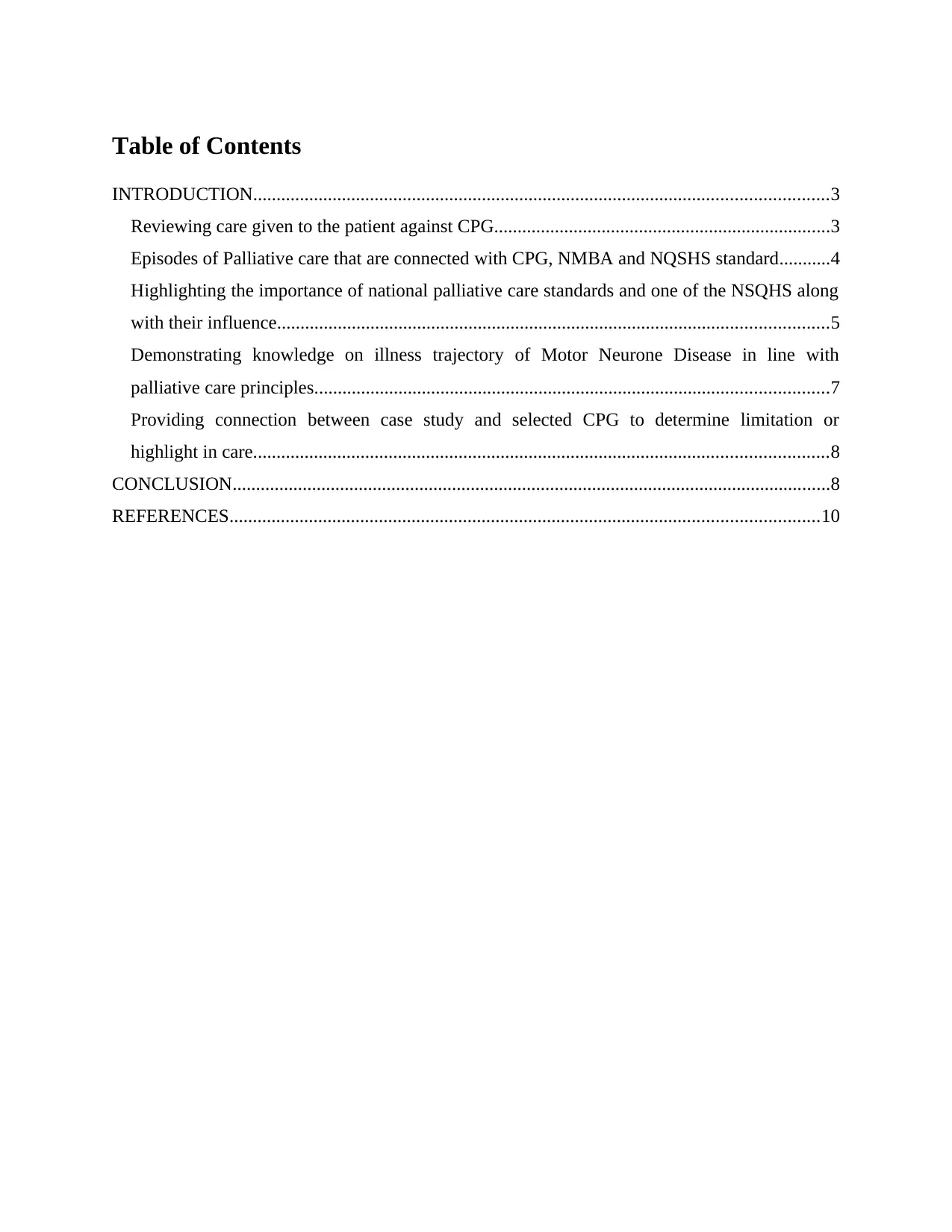
Table of Contents
INTRODUCTION...........................................................................................................................3
Reviewing care given to the patient against CPG........................................................................3
Episodes of Palliative care that are connected with CPG, NMBA and NQSHS standard...........4
Highlighting the importance of national palliative care standards and one of the NSQHS along
with their influence......................................................................................................................5
Demonstrating knowledge on illness trajectory of Motor Neurone Disease in line with
palliative care principles..............................................................................................................7
Providing connection between case study and selected CPG to determine limitation or
highlight in care...........................................................................................................................8
CONCLUSION................................................................................................................................8
REFERENCES..............................................................................................................................10
INTRODUCTION...........................................................................................................................3
Reviewing care given to the patient against CPG........................................................................3
Episodes of Palliative care that are connected with CPG, NMBA and NQSHS standard...........4
Highlighting the importance of national palliative care standards and one of the NSQHS along
with their influence......................................................................................................................5
Demonstrating knowledge on illness trajectory of Motor Neurone Disease in line with
palliative care principles..............................................................................................................7
Providing connection between case study and selected CPG to determine limitation or
highlight in care...........................................................................................................................8
CONCLUSION................................................................................................................................8
REFERENCES..............................................................................................................................10
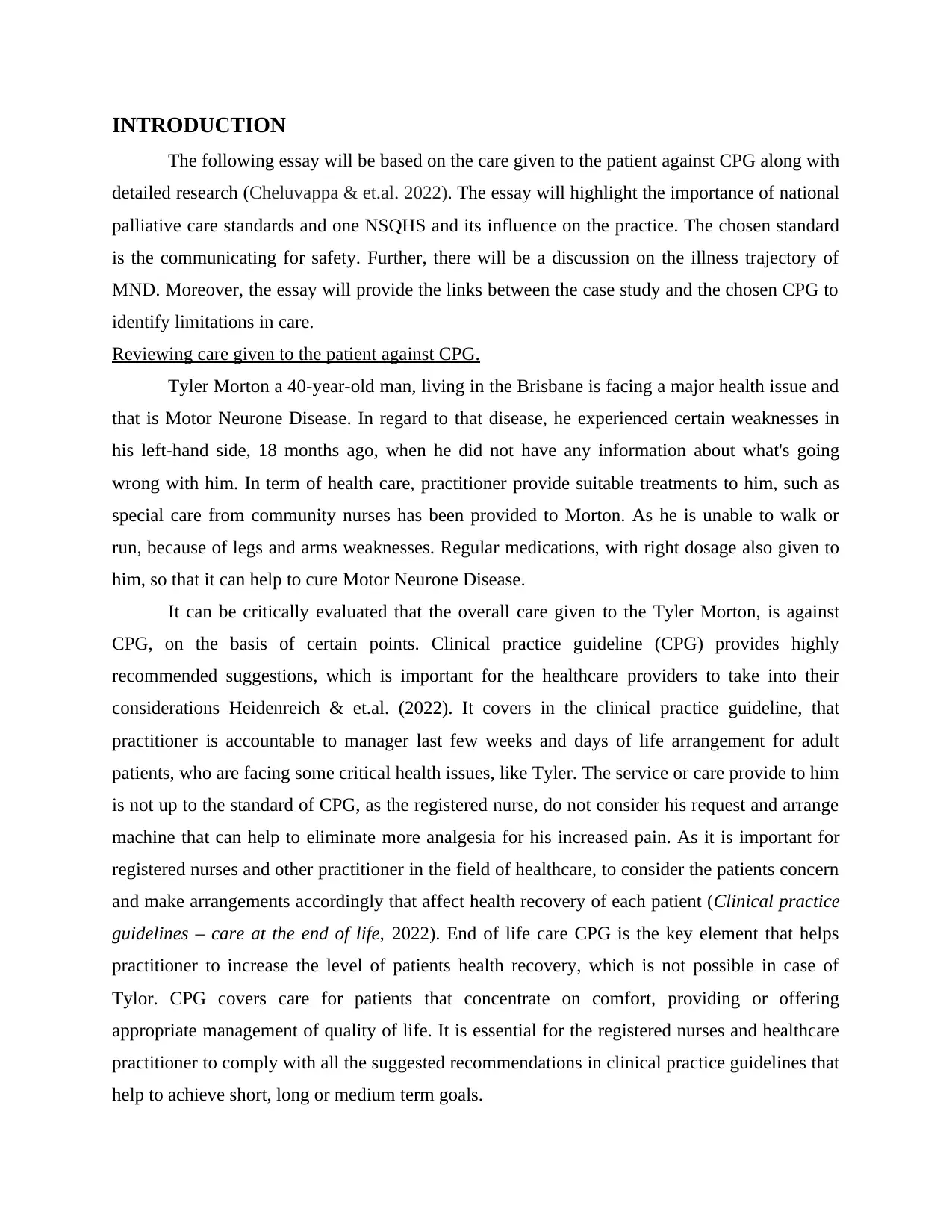
INTRODUCTION
The following essay will be based on the care given to the patient against CPG along with
detailed research (Cheluvappa & et.al. 2022). The essay will highlight the importance of national
palliative care standards and one NSQHS and its influence on the practice. The chosen standard
is the communicating for safety. Further, there will be a discussion on the illness trajectory of
MND. Moreover, the essay will provide the links between the case study and the chosen CPG to
identify limitations in care.
Reviewing care given to the patient against CPG.
Tyler Morton a 40-year-old man, living in the Brisbane is facing a major health issue and
that is Motor Neurone Disease. In regard to that disease, he experienced certain weaknesses in
his left-hand side, 18 months ago, when he did not have any information about what's going
wrong with him. In term of health care, practitioner provide suitable treatments to him, such as
special care from community nurses has been provided to Morton. As he is unable to walk or
run, because of legs and arms weaknesses. Regular medications, with right dosage also given to
him, so that it can help to cure Motor Neurone Disease.
It can be critically evaluated that the overall care given to the Tyler Morton, is against
CPG, on the basis of certain points. Clinical practice guideline (CPG) provides highly
recommended suggestions, which is important for the healthcare providers to take into their
considerations Heidenreich & et.al. (2022). It covers in the clinical practice guideline, that
practitioner is accountable to manager last few weeks and days of life arrangement for adult
patients, who are facing some critical health issues, like Tyler. The service or care provide to him
is not up to the standard of CPG, as the registered nurse, do not consider his request and arrange
machine that can help to eliminate more analgesia for his increased pain. As it is important for
registered nurses and other practitioner in the field of healthcare, to consider the patients concern
and make arrangements accordingly that affect health recovery of each patient (Clinical practice
guidelines – care at the end of life, 2022). End of life care CPG is the key element that helps
practitioner to increase the level of patients health recovery, which is not possible in case of
Tylor. CPG covers care for patients that concentrate on comfort, providing or offering
appropriate management of quality of life. It is essential for the registered nurses and healthcare
practitioner to comply with all the suggested recommendations in clinical practice guidelines that
help to achieve short, long or medium term goals.
The following essay will be based on the care given to the patient against CPG along with
detailed research (Cheluvappa & et.al. 2022). The essay will highlight the importance of national
palliative care standards and one NSQHS and its influence on the practice. The chosen standard
is the communicating for safety. Further, there will be a discussion on the illness trajectory of
MND. Moreover, the essay will provide the links between the case study and the chosen CPG to
identify limitations in care.
Reviewing care given to the patient against CPG.
Tyler Morton a 40-year-old man, living in the Brisbane is facing a major health issue and
that is Motor Neurone Disease. In regard to that disease, he experienced certain weaknesses in
his left-hand side, 18 months ago, when he did not have any information about what's going
wrong with him. In term of health care, practitioner provide suitable treatments to him, such as
special care from community nurses has been provided to Morton. As he is unable to walk or
run, because of legs and arms weaknesses. Regular medications, with right dosage also given to
him, so that it can help to cure Motor Neurone Disease.
It can be critically evaluated that the overall care given to the Tyler Morton, is against
CPG, on the basis of certain points. Clinical practice guideline (CPG) provides highly
recommended suggestions, which is important for the healthcare providers to take into their
considerations Heidenreich & et.al. (2022). It covers in the clinical practice guideline, that
practitioner is accountable to manager last few weeks and days of life arrangement for adult
patients, who are facing some critical health issues, like Tyler. The service or care provide to him
is not up to the standard of CPG, as the registered nurse, do not consider his request and arrange
machine that can help to eliminate more analgesia for his increased pain. As it is important for
registered nurses and other practitioner in the field of healthcare, to consider the patients concern
and make arrangements accordingly that affect health recovery of each patient (Clinical practice
guidelines – care at the end of life, 2022). End of life care CPG is the key element that helps
practitioner to increase the level of patients health recovery, which is not possible in case of
Tylor. CPG covers care for patients that concentrate on comfort, providing or offering
appropriate management of quality of life. It is essential for the registered nurses and healthcare
practitioner to comply with all the suggested recommendations in clinical practice guidelines that
help to achieve short, long or medium term goals.
⊘ This is a preview!⊘
Do you want full access?
Subscribe today to unlock all pages.

Trusted by 1+ million students worldwide
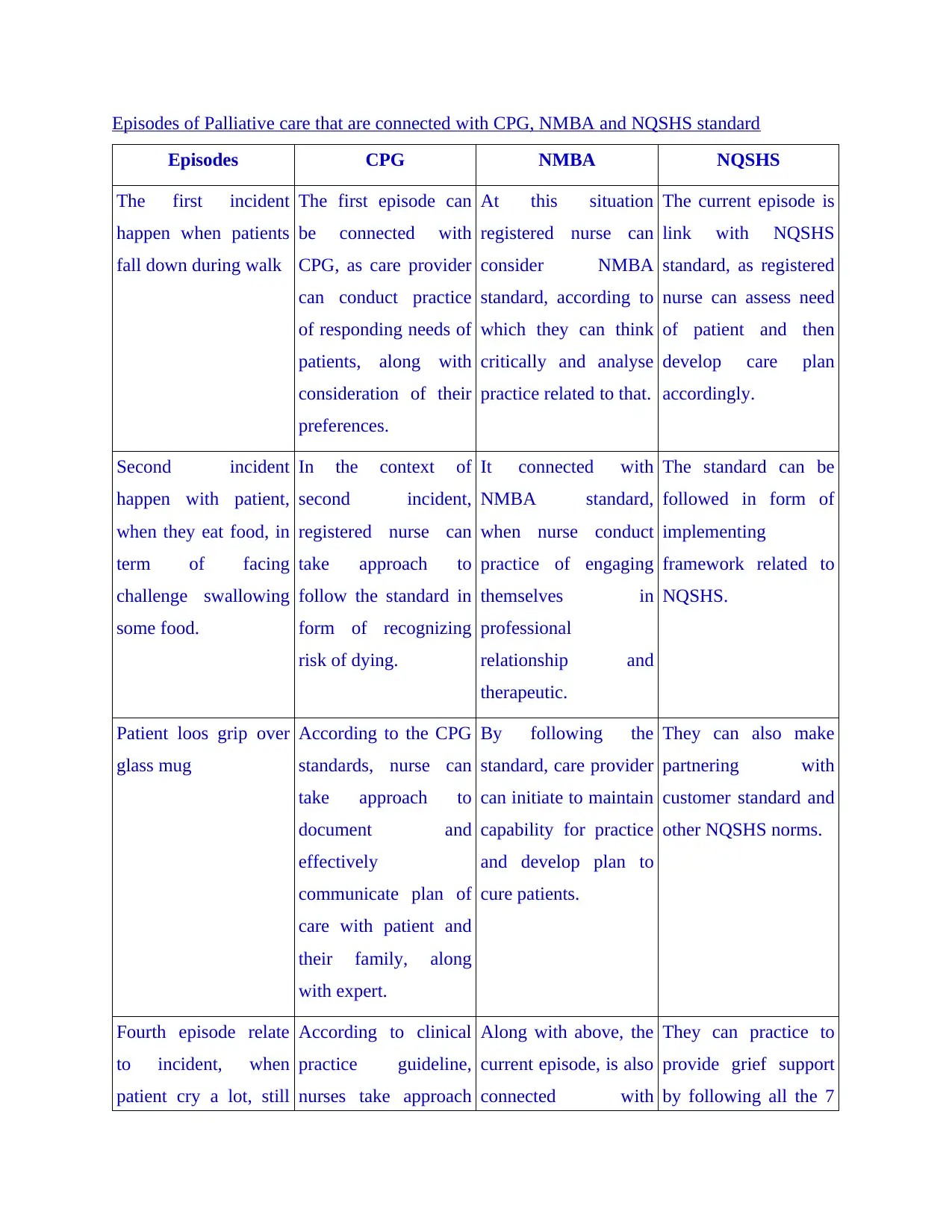
Episodes of Palliative care that are connected with CPG, NMBA and NQSHS standard
Episodes CPG NMBA NQSHS
The first incident
happen when patients
fall down during walk
The first episode can
be connected with
CPG, as care provider
can conduct practice
of responding needs of
patients, along with
consideration of their
preferences.
At this situation
registered nurse can
consider NMBA
standard, according to
which they can think
critically and analyse
practice related to that.
The current episode is
link with NQSHS
standard, as registered
nurse can assess need
of patient and then
develop care plan
accordingly.
Second incident
happen with patient,
when they eat food, in
term of facing
challenge swallowing
some food.
In the context of
second incident,
registered nurse can
take approach to
follow the standard in
form of recognizing
risk of dying.
It connected with
NMBA standard,
when nurse conduct
practice of engaging
themselves in
professional
relationship and
therapeutic.
The standard can be
followed in form of
implementing
framework related to
NQSHS.
Patient loos grip over
glass mug
According to the CPG
standards, nurse can
take approach to
document and
effectively
communicate plan of
care with patient and
their family, along
with expert.
By following the
standard, care provider
can initiate to maintain
capability for practice
and develop plan to
cure patients.
They can also make
partnering with
customer standard and
other NQSHS norms.
Fourth episode relate
to incident, when
patient cry a lot, still
According to clinical
practice guideline,
nurses take approach
Along with above, the
current episode, is also
connected with
They can practice to
provide grief support
by following all the 7
Episodes CPG NMBA NQSHS
The first incident
happen when patients
fall down during walk
The first episode can
be connected with
CPG, as care provider
can conduct practice
of responding needs of
patients, along with
consideration of their
preferences.
At this situation
registered nurse can
consider NMBA
standard, according to
which they can think
critically and analyse
practice related to that.
The current episode is
link with NQSHS
standard, as registered
nurse can assess need
of patient and then
develop care plan
accordingly.
Second incident
happen with patient,
when they eat food, in
term of facing
challenge swallowing
some food.
In the context of
second incident,
registered nurse can
take approach to
follow the standard in
form of recognizing
risk of dying.
It connected with
NMBA standard,
when nurse conduct
practice of engaging
themselves in
professional
relationship and
therapeutic.
The standard can be
followed in form of
implementing
framework related to
NQSHS.
Patient loos grip over
glass mug
According to the CPG
standards, nurse can
take approach to
document and
effectively
communicate plan of
care with patient and
their family, along
with expert.
By following the
standard, care provider
can initiate to maintain
capability for practice
and develop plan to
cure patients.
They can also make
partnering with
customer standard and
other NQSHS norms.
Fourth episode relate
to incident, when
patient cry a lot, still
According to clinical
practice guideline,
nurses take approach
Along with above, the
current episode, is also
connected with
They can practice to
provide grief support
by following all the 7
Paraphrase This Document
Need a fresh take? Get an instant paraphrase of this document with our AI Paraphraser
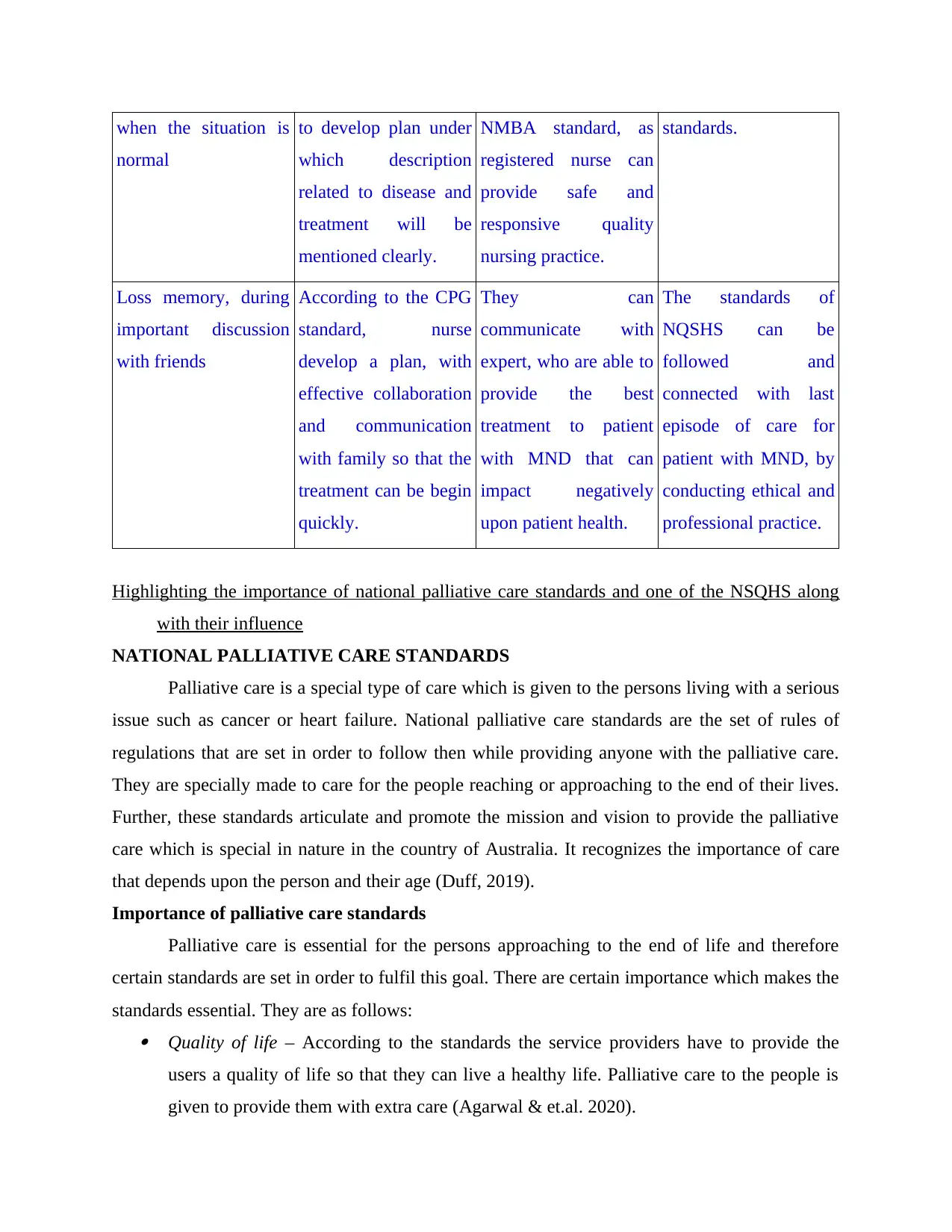
when the situation is
normal
to develop plan under
which description
related to disease and
treatment will be
mentioned clearly.
NMBA standard, as
registered nurse can
provide safe and
responsive quality
nursing practice.
standards.
Loss memory, during
important discussion
with friends
According to the CPG
standard, nurse
develop a plan, with
effective collaboration
and communication
with family so that the
treatment can be begin
quickly.
They can
communicate with
expert, who are able to
provide the best
treatment to patient
with MND that can
impact negatively
upon patient health.
The standards of
NQSHS can be
followed and
connected with last
episode of care for
patient with MND, by
conducting ethical and
professional practice.
Highlighting the importance of national palliative care standards and one of the NSQHS along
with their influence
NATIONAL PALLIATIVE CARE STANDARDS
Palliative care is a special type of care which is given to the persons living with a serious
issue such as cancer or heart failure. National palliative care standards are the set of rules of
regulations that are set in order to follow then while providing anyone with the palliative care.
They are specially made to care for the people reaching or approaching to the end of their lives.
Further, these standards articulate and promote the mission and vision to provide the palliative
care which is special in nature in the country of Australia. It recognizes the importance of care
that depends upon the person and their age (Duff, 2019).
Importance of palliative care standards
Palliative care is essential for the persons approaching to the end of life and therefore
certain standards are set in order to fulfil this goal. There are certain importance which makes the
standards essential. They are as follows: Quality of life – According to the standards the service providers have to provide the
users a quality of life so that they can live a healthy life. Palliative care to the people is
given to provide them with extra care (Agarwal & et.al. 2020).
normal
to develop plan under
which description
related to disease and
treatment will be
mentioned clearly.
NMBA standard, as
registered nurse can
provide safe and
responsive quality
nursing practice.
standards.
Loss memory, during
important discussion
with friends
According to the CPG
standard, nurse
develop a plan, with
effective collaboration
and communication
with family so that the
treatment can be begin
quickly.
They can
communicate with
expert, who are able to
provide the best
treatment to patient
with MND that can
impact negatively
upon patient health.
The standards of
NQSHS can be
followed and
connected with last
episode of care for
patient with MND, by
conducting ethical and
professional practice.
Highlighting the importance of national palliative care standards and one of the NSQHS along
with their influence
NATIONAL PALLIATIVE CARE STANDARDS
Palliative care is a special type of care which is given to the persons living with a serious
issue such as cancer or heart failure. National palliative care standards are the set of rules of
regulations that are set in order to follow then while providing anyone with the palliative care.
They are specially made to care for the people reaching or approaching to the end of their lives.
Further, these standards articulate and promote the mission and vision to provide the palliative
care which is special in nature in the country of Australia. It recognizes the importance of care
that depends upon the person and their age (Duff, 2019).
Importance of palliative care standards
Palliative care is essential for the persons approaching to the end of life and therefore
certain standards are set in order to fulfil this goal. There are certain importance which makes the
standards essential. They are as follows: Quality of life – According to the standards the service providers have to provide the
users a quality of life so that they can live a healthy life. Palliative care to the people is
given to provide them with extra care (Agarwal & et.al. 2020).
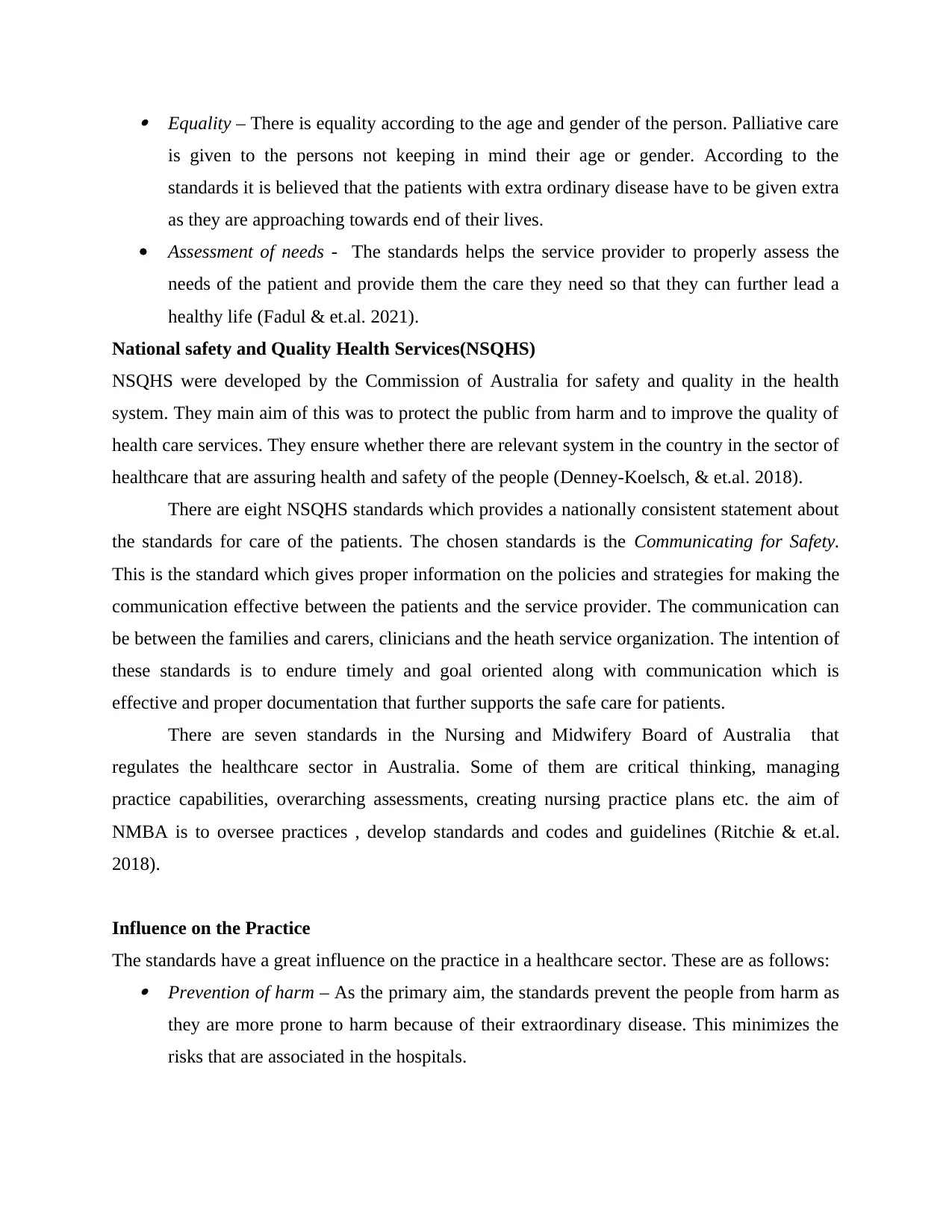
Equality – There is equality according to the age and gender of the person. Palliative care
is given to the persons not keeping in mind their age or gender. According to the
standards it is believed that the patients with extra ordinary disease have to be given extra
as they are approaching towards end of their lives.
Assessment of needs - The standards helps the service provider to properly assess the
needs of the patient and provide them the care they need so that they can further lead a
healthy life (Fadul & et.al. 2021).
National safety and Quality Health Services(NSQHS)
NSQHS were developed by the Commission of Australia for safety and quality in the health
system. They main aim of this was to protect the public from harm and to improve the quality of
health care services. They ensure whether there are relevant system in the country in the sector of
healthcare that are assuring health and safety of the people (Denney-Koelsch, & et.al. 2018).
There are eight NSQHS standards which provides a nationally consistent statement about
the standards for care of the patients. The chosen standards is the Communicating for Safety.
This is the standard which gives proper information on the policies and strategies for making the
communication effective between the patients and the service provider. The communication can
be between the families and carers, clinicians and the heath service organization. The intention of
these standards is to endure timely and goal oriented along with communication which is
effective and proper documentation that further supports the safe care for patients.
There are seven standards in the Nursing and Midwifery Board of Australia that
regulates the healthcare sector in Australia. Some of them are critical thinking, managing
practice capabilities, overarching assessments, creating nursing practice plans etc. the aim of
NMBA is to oversee practices , develop standards and codes and guidelines (Ritchie & et.al.
2018).
Influence on the Practice
The standards have a great influence on the practice in a healthcare sector. These are as follows: Prevention of harm – As the primary aim, the standards prevent the people from harm as
they are more prone to harm because of their extraordinary disease. This minimizes the
risks that are associated in the hospitals.
is given to the persons not keeping in mind their age or gender. According to the
standards it is believed that the patients with extra ordinary disease have to be given extra
as they are approaching towards end of their lives.
Assessment of needs - The standards helps the service provider to properly assess the
needs of the patient and provide them the care they need so that they can further lead a
healthy life (Fadul & et.al. 2021).
National safety and Quality Health Services(NSQHS)
NSQHS were developed by the Commission of Australia for safety and quality in the health
system. They main aim of this was to protect the public from harm and to improve the quality of
health care services. They ensure whether there are relevant system in the country in the sector of
healthcare that are assuring health and safety of the people (Denney-Koelsch, & et.al. 2018).
There are eight NSQHS standards which provides a nationally consistent statement about
the standards for care of the patients. The chosen standards is the Communicating for Safety.
This is the standard which gives proper information on the policies and strategies for making the
communication effective between the patients and the service provider. The communication can
be between the families and carers, clinicians and the heath service organization. The intention of
these standards is to endure timely and goal oriented along with communication which is
effective and proper documentation that further supports the safe care for patients.
There are seven standards in the Nursing and Midwifery Board of Australia that
regulates the healthcare sector in Australia. Some of them are critical thinking, managing
practice capabilities, overarching assessments, creating nursing practice plans etc. the aim of
NMBA is to oversee practices , develop standards and codes and guidelines (Ritchie & et.al.
2018).
Influence on the Practice
The standards have a great influence on the practice in a healthcare sector. These are as follows: Prevention of harm – As the primary aim, the standards prevent the people from harm as
they are more prone to harm because of their extraordinary disease. This minimizes the
risks that are associated in the hospitals.
⊘ This is a preview!⊘
Do you want full access?
Subscribe today to unlock all pages.

Trusted by 1+ million students worldwide
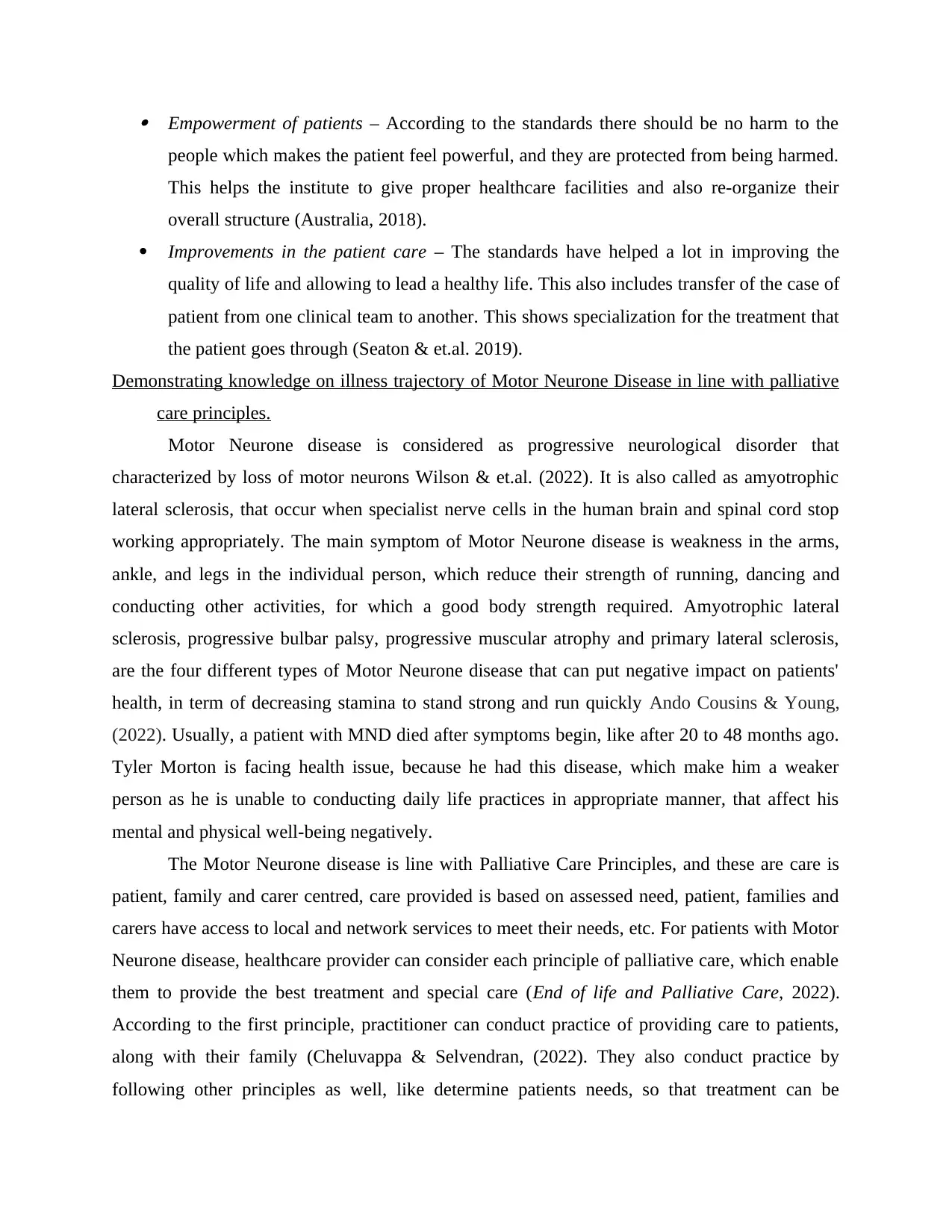
Empowerment of patients – According to the standards there should be no harm to the
people which makes the patient feel powerful, and they are protected from being harmed.
This helps the institute to give proper healthcare facilities and also re-organize their
overall structure (Australia, 2018).
Improvements in the patient care – The standards have helped a lot in improving the
quality of life and allowing to lead a healthy life. This also includes transfer of the case of
patient from one clinical team to another. This shows specialization for the treatment that
the patient goes through (Seaton & et.al. 2019).
Demonstrating knowledge on illness trajectory of Motor Neurone Disease in line with palliative
care principles.
Motor Neurone disease is considered as progressive neurological disorder that
characterized by loss of motor neurons Wilson & et.al. (2022). It is also called as amyotrophic
lateral sclerosis, that occur when specialist nerve cells in the human brain and spinal cord stop
working appropriately. The main symptom of Motor Neurone disease is weakness in the arms,
ankle, and legs in the individual person, which reduce their strength of running, dancing and
conducting other activities, for which a good body strength required. Amyotrophic lateral
sclerosis, progressive bulbar palsy, progressive muscular atrophy and primary lateral sclerosis,
are the four different types of Motor Neurone disease that can put negative impact on patients'
health, in term of decreasing stamina to stand strong and run quickly Ando Cousins & Young,
(2022). Usually, a patient with MND died after symptoms begin, like after 20 to 48 months ago.
Tyler Morton is facing health issue, because he had this disease, which make him a weaker
person as he is unable to conducting daily life practices in appropriate manner, that affect his
mental and physical well-being negatively.
The Motor Neurone disease is line with Palliative Care Principles, and these are care is
patient, family and carer centred, care provided is based on assessed need, patient, families and
carers have access to local and network services to meet their needs, etc. For patients with Motor
Neurone disease, healthcare provider can consider each principle of palliative care, which enable
them to provide the best treatment and special care (End of life and Palliative Care, 2022).
According to the first principle, practitioner can conduct practice of providing care to patients,
along with their family (Cheluvappa & Selvendran, (2022). They also conduct practice by
following other principles as well, like determine patients needs, so that treatment can be
people which makes the patient feel powerful, and they are protected from being harmed.
This helps the institute to give proper healthcare facilities and also re-organize their
overall structure (Australia, 2018).
Improvements in the patient care – The standards have helped a lot in improving the
quality of life and allowing to lead a healthy life. This also includes transfer of the case of
patient from one clinical team to another. This shows specialization for the treatment that
the patient goes through (Seaton & et.al. 2019).
Demonstrating knowledge on illness trajectory of Motor Neurone Disease in line with palliative
care principles.
Motor Neurone disease is considered as progressive neurological disorder that
characterized by loss of motor neurons Wilson & et.al. (2022). It is also called as amyotrophic
lateral sclerosis, that occur when specialist nerve cells in the human brain and spinal cord stop
working appropriately. The main symptom of Motor Neurone disease is weakness in the arms,
ankle, and legs in the individual person, which reduce their strength of running, dancing and
conducting other activities, for which a good body strength required. Amyotrophic lateral
sclerosis, progressive bulbar palsy, progressive muscular atrophy and primary lateral sclerosis,
are the four different types of Motor Neurone disease that can put negative impact on patients'
health, in term of decreasing stamina to stand strong and run quickly Ando Cousins & Young,
(2022). Usually, a patient with MND died after symptoms begin, like after 20 to 48 months ago.
Tyler Morton is facing health issue, because he had this disease, which make him a weaker
person as he is unable to conducting daily life practices in appropriate manner, that affect his
mental and physical well-being negatively.
The Motor Neurone disease is line with Palliative Care Principles, and these are care is
patient, family and carer centred, care provided is based on assessed need, patient, families and
carers have access to local and network services to meet their needs, etc. For patients with Motor
Neurone disease, healthcare provider can consider each principle of palliative care, which enable
them to provide the best treatment and special care (End of life and Palliative Care, 2022).
According to the first principle, practitioner can conduct practice of providing care to patients,
along with their family (Cheluvappa & Selvendran, (2022). They also conduct practice by
following other principles as well, like determine patients needs, so that treatment can be
Paraphrase This Document
Need a fresh take? Get an instant paraphrase of this document with our AI Paraphraser
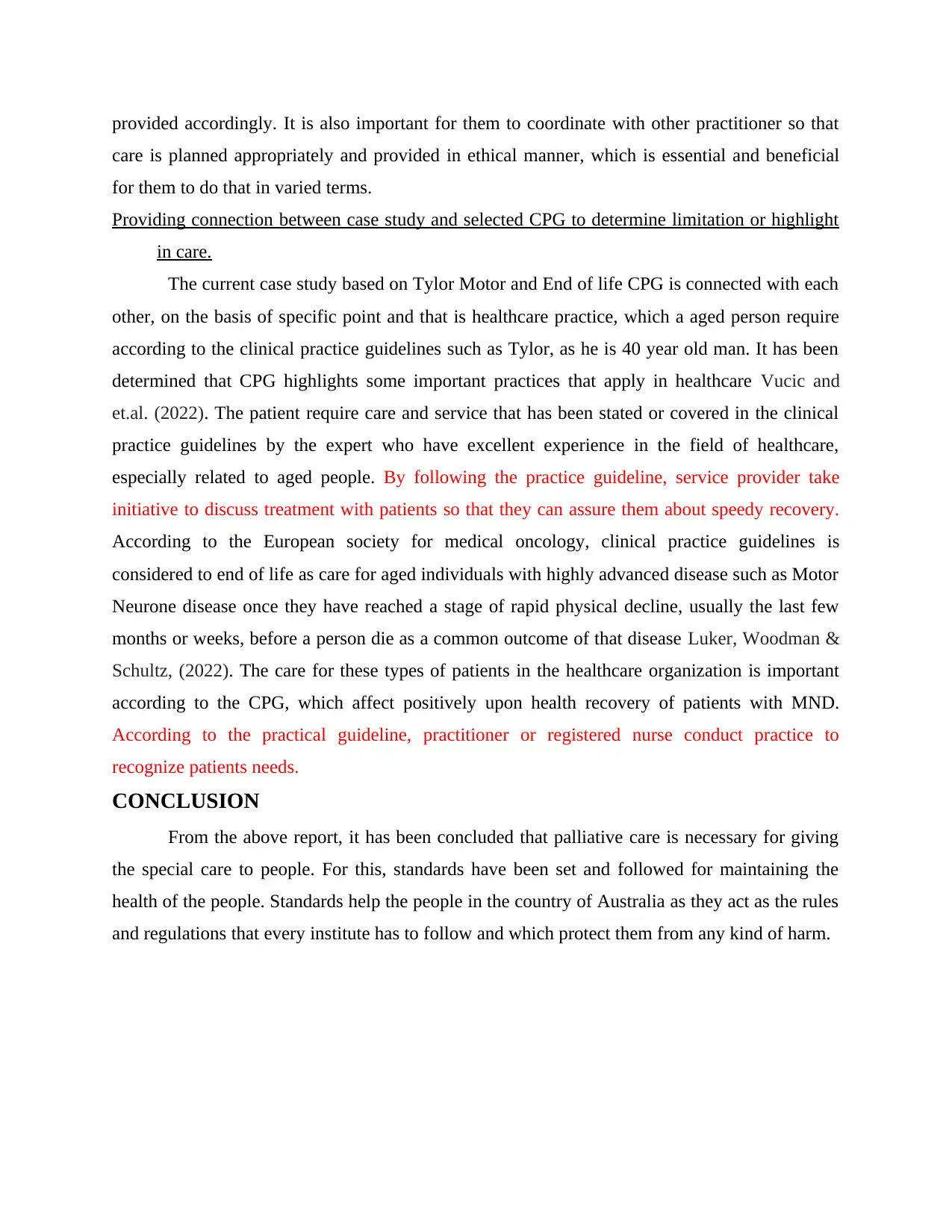
provided accordingly. It is also important for them to coordinate with other practitioner so that
care is planned appropriately and provided in ethical manner, which is essential and beneficial
for them to do that in varied terms.
Providing connection between case study and selected CPG to determine limitation or highlight
in care.
The current case study based on Tylor Motor and End of life CPG is connected with each
other, on the basis of specific point and that is healthcare practice, which a aged person require
according to the clinical practice guidelines such as Tylor, as he is 40 year old man. It has been
determined that CPG highlights some important practices that apply in healthcare Vucic and
et.al. (2022). The patient require care and service that has been stated or covered in the clinical
practice guidelines by the expert who have excellent experience in the field of healthcare,
especially related to aged people. By following the practice guideline, service provider take
initiative to discuss treatment with patients so that they can assure them about speedy recovery.
According to the European society for medical oncology, clinical practice guidelines is
considered to end of life as care for aged individuals with highly advanced disease such as Motor
Neurone disease once they have reached a stage of rapid physical decline, usually the last few
months or weeks, before a person die as a common outcome of that disease Luker, Woodman &
Schultz, (2022). The care for these types of patients in the healthcare organization is important
according to the CPG, which affect positively upon health recovery of patients with MND.
According to the practical guideline, practitioner or registered nurse conduct practice to
recognize patients needs.
CONCLUSION
From the above report, it has been concluded that palliative care is necessary for giving
the special care to people. For this, standards have been set and followed for maintaining the
health of the people. Standards help the people in the country of Australia as they act as the rules
and regulations that every institute has to follow and which protect them from any kind of harm.
care is planned appropriately and provided in ethical manner, which is essential and beneficial
for them to do that in varied terms.
Providing connection between case study and selected CPG to determine limitation or highlight
in care.
The current case study based on Tylor Motor and End of life CPG is connected with each
other, on the basis of specific point and that is healthcare practice, which a aged person require
according to the clinical practice guidelines such as Tylor, as he is 40 year old man. It has been
determined that CPG highlights some important practices that apply in healthcare Vucic and
et.al. (2022). The patient require care and service that has been stated or covered in the clinical
practice guidelines by the expert who have excellent experience in the field of healthcare,
especially related to aged people. By following the practice guideline, service provider take
initiative to discuss treatment with patients so that they can assure them about speedy recovery.
According to the European society for medical oncology, clinical practice guidelines is
considered to end of life as care for aged individuals with highly advanced disease such as Motor
Neurone disease once they have reached a stage of rapid physical decline, usually the last few
months or weeks, before a person die as a common outcome of that disease Luker, Woodman &
Schultz, (2022). The care for these types of patients in the healthcare organization is important
according to the CPG, which affect positively upon health recovery of patients with MND.
According to the practical guideline, practitioner or registered nurse conduct practice to
recognize patients needs.
CONCLUSION
From the above report, it has been concluded that palliative care is necessary for giving
the special care to people. For this, standards have been set and followed for maintaining the
health of the people. Standards help the people in the country of Australia as they act as the rules
and regulations that every institute has to follow and which protect them from any kind of harm.

⊘ This is a preview!⊘
Do you want full access?
Subscribe today to unlock all pages.

Trusted by 1+ million students worldwide
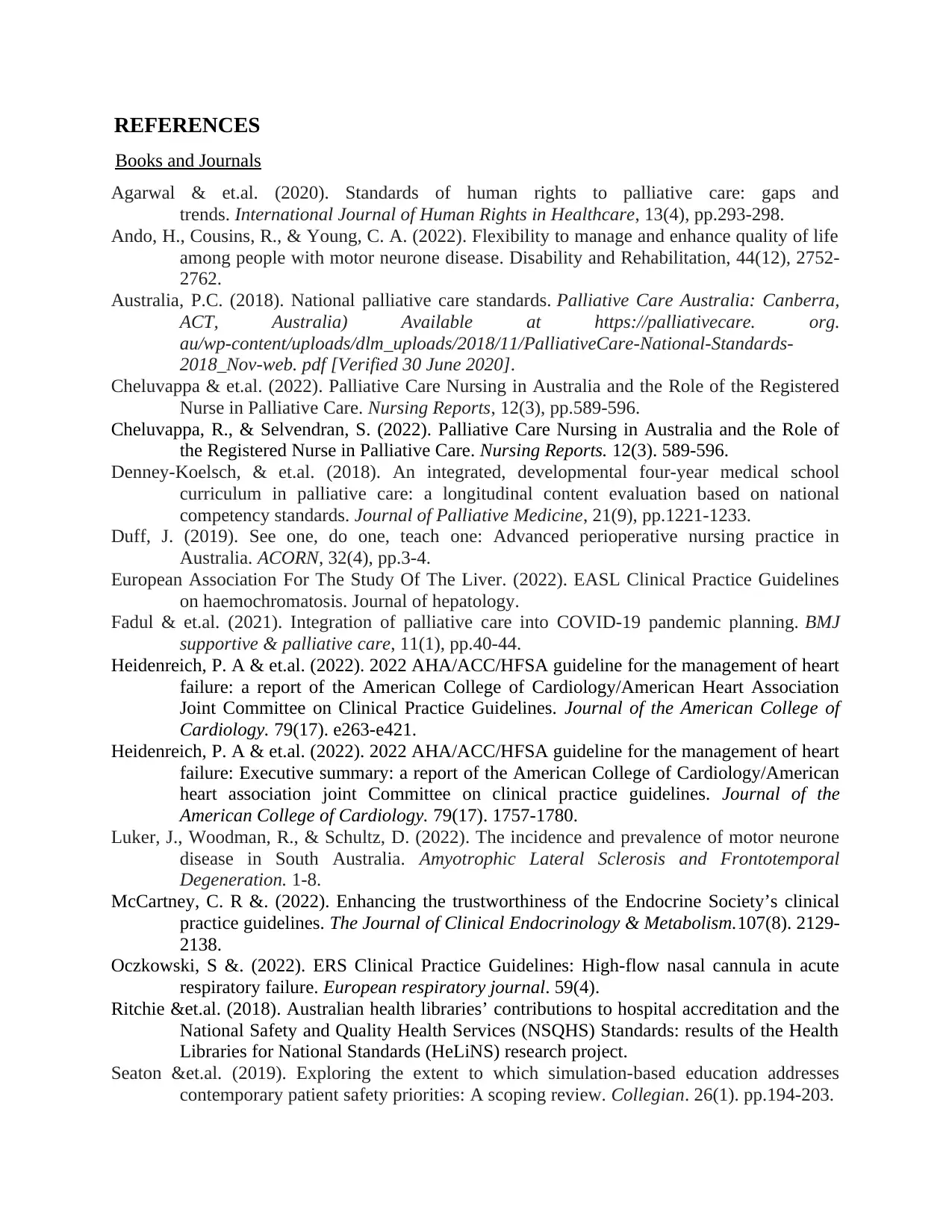
REFERENCES
Books and Journals
Agarwal & et.al. (2020). Standards of human rights to palliative care: gaps and
trends. International Journal of Human Rights in Healthcare, 13(4), pp.293-298.
Ando, H., Cousins, R., & Young, C. A. (2022). Flexibility to manage and enhance quality of life
among people with motor neurone disease. Disability and Rehabilitation, 44(12), 2752-
2762.
Australia, P.C. (2018). National palliative care standards. Palliative Care Australia: Canberra,
ACT, Australia) Available at https://palliativecare. org.
au/wp-content/uploads/dlm_uploads/2018/11/PalliativeCare-National-Standards-
2018_Nov-web. pdf [Verified 30 June 2020].
Cheluvappa & et.al. (2022). Palliative Care Nursing in Australia and the Role of the Registered
Nurse in Palliative Care. Nursing Reports, 12(3), pp.589-596.
Cheluvappa, R., & Selvendran, S. (2022). Palliative Care Nursing in Australia and the Role of
the Registered Nurse in Palliative Care. Nursing Reports. 12(3). 589-596.
Denney-Koelsch, & et.al. (2018). An integrated, developmental four-year medical school
curriculum in palliative care: a longitudinal content evaluation based on national
competency standards. Journal of Palliative Medicine, 21(9), pp.1221-1233.
Duff, J. (2019). See one, do one, teach one: Advanced perioperative nursing practice in
Australia. ACORN, 32(4), pp.3-4.
European Association For The Study Of The Liver. (2022). EASL Clinical Practice Guidelines
on haemochromatosis. Journal of hepatology.
Fadul & et.al. (2021). Integration of palliative care into COVID-19 pandemic planning. BMJ
supportive & palliative care, 11(1), pp.40-44.
Heidenreich, P. A & et.al. (2022). 2022 AHA/ACC/HFSA guideline for the management of heart
failure: a report of the American College of Cardiology/American Heart Association
Joint Committee on Clinical Practice Guidelines. Journal of the American College of
Cardiology. 79(17). e263-e421.
Heidenreich, P. A & et.al. (2022). 2022 AHA/ACC/HFSA guideline for the management of heart
failure: Executive summary: a report of the American College of Cardiology/American
heart association joint Committee on clinical practice guidelines. Journal of the
American College of Cardiology. 79(17). 1757-1780.
Luker, J., Woodman, R., & Schultz, D. (2022). The incidence and prevalence of motor neurone
disease in South Australia. Amyotrophic Lateral Sclerosis and Frontotemporal
Degeneration. 1-8.
McCartney, C. R &. (2022). Enhancing the trustworthiness of the Endocrine Society’s clinical
practice guidelines. The Journal of Clinical Endocrinology & Metabolism.107(8). 2129-
2138.
Oczkowski, S &. (2022). ERS Clinical Practice Guidelines: High-flow nasal cannula in acute
respiratory failure. European respiratory journal. 59(4).
Ritchie &et.al. (2018). Australian health libraries’ contributions to hospital accreditation and the
National Safety and Quality Health Services (NSQHS) Standards: results of the Health
Libraries for National Standards (HeLiNS) research project.
Seaton &et.al. (2019). Exploring the extent to which simulation-based education addresses
contemporary patient safety priorities: A scoping review. Collegian. 26(1). pp.194-203.
Books and Journals
Agarwal & et.al. (2020). Standards of human rights to palliative care: gaps and
trends. International Journal of Human Rights in Healthcare, 13(4), pp.293-298.
Ando, H., Cousins, R., & Young, C. A. (2022). Flexibility to manage and enhance quality of life
among people with motor neurone disease. Disability and Rehabilitation, 44(12), 2752-
2762.
Australia, P.C. (2018). National palliative care standards. Palliative Care Australia: Canberra,
ACT, Australia) Available at https://palliativecare. org.
au/wp-content/uploads/dlm_uploads/2018/11/PalliativeCare-National-Standards-
2018_Nov-web. pdf [Verified 30 June 2020].
Cheluvappa & et.al. (2022). Palliative Care Nursing in Australia and the Role of the Registered
Nurse in Palliative Care. Nursing Reports, 12(3), pp.589-596.
Cheluvappa, R., & Selvendran, S. (2022). Palliative Care Nursing in Australia and the Role of
the Registered Nurse in Palliative Care. Nursing Reports. 12(3). 589-596.
Denney-Koelsch, & et.al. (2018). An integrated, developmental four-year medical school
curriculum in palliative care: a longitudinal content evaluation based on national
competency standards. Journal of Palliative Medicine, 21(9), pp.1221-1233.
Duff, J. (2019). See one, do one, teach one: Advanced perioperative nursing practice in
Australia. ACORN, 32(4), pp.3-4.
European Association For The Study Of The Liver. (2022). EASL Clinical Practice Guidelines
on haemochromatosis. Journal of hepatology.
Fadul & et.al. (2021). Integration of palliative care into COVID-19 pandemic planning. BMJ
supportive & palliative care, 11(1), pp.40-44.
Heidenreich, P. A & et.al. (2022). 2022 AHA/ACC/HFSA guideline for the management of heart
failure: a report of the American College of Cardiology/American Heart Association
Joint Committee on Clinical Practice Guidelines. Journal of the American College of
Cardiology. 79(17). e263-e421.
Heidenreich, P. A & et.al. (2022). 2022 AHA/ACC/HFSA guideline for the management of heart
failure: Executive summary: a report of the American College of Cardiology/American
heart association joint Committee on clinical practice guidelines. Journal of the
American College of Cardiology. 79(17). 1757-1780.
Luker, J., Woodman, R., & Schultz, D. (2022). The incidence and prevalence of motor neurone
disease in South Australia. Amyotrophic Lateral Sclerosis and Frontotemporal
Degeneration. 1-8.
McCartney, C. R &. (2022). Enhancing the trustworthiness of the Endocrine Society’s clinical
practice guidelines. The Journal of Clinical Endocrinology & Metabolism.107(8). 2129-
2138.
Oczkowski, S &. (2022). ERS Clinical Practice Guidelines: High-flow nasal cannula in acute
respiratory failure. European respiratory journal. 59(4).
Ritchie &et.al. (2018). Australian health libraries’ contributions to hospital accreditation and the
National Safety and Quality Health Services (NSQHS) Standards: results of the Health
Libraries for National Standards (HeLiNS) research project.
Seaton &et.al. (2019). Exploring the extent to which simulation-based education addresses
contemporary patient safety priorities: A scoping review. Collegian. 26(1). pp.194-203.
Paraphrase This Document
Need a fresh take? Get an instant paraphrase of this document with our AI Paraphraser
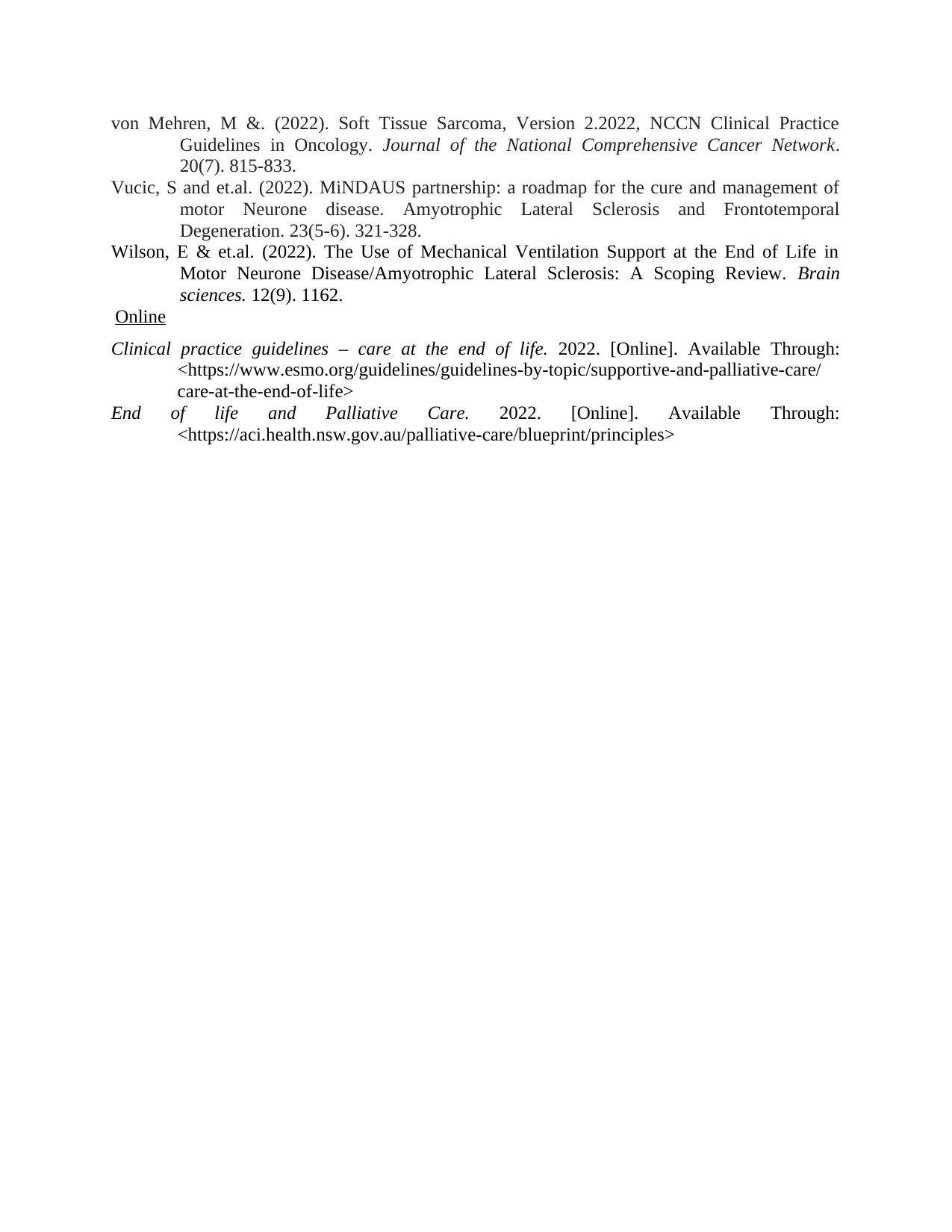
von Mehren, M &. (2022). Soft Tissue Sarcoma, Version 2.2022, NCCN Clinical Practice
Guidelines in Oncology. Journal of the National Comprehensive Cancer Network.
20(7). 815-833.
Vucic, S and et.al. (2022). MiNDAUS partnership: a roadmap for the cure and management of
motor Neurone disease. Amyotrophic Lateral Sclerosis and Frontotemporal
Degeneration. 23(5-6). 321-328.
Wilson, E & et.al. (2022). The Use of Mechanical Ventilation Support at the End of Life in
Motor Neurone Disease/Amyotrophic Lateral Sclerosis: A Scoping Review. Brain
sciences. 12(9). 1162.
Online
Clinical practice guidelines – care at the end of life. 2022. [Online]. Available Through:
<https://www.esmo.org/guidelines/guidelines-by-topic/supportive-and-palliative-care/
care-at-the-end-of-life>
End of life and Palliative Care. 2022. [Online]. Available Through:
<https://aci.health.nsw.gov.au/palliative-care/blueprint/principles>
Guidelines in Oncology. Journal of the National Comprehensive Cancer Network.
20(7). 815-833.
Vucic, S and et.al. (2022). MiNDAUS partnership: a roadmap for the cure and management of
motor Neurone disease. Amyotrophic Lateral Sclerosis and Frontotemporal
Degeneration. 23(5-6). 321-328.
Wilson, E & et.al. (2022). The Use of Mechanical Ventilation Support at the End of Life in
Motor Neurone Disease/Amyotrophic Lateral Sclerosis: A Scoping Review. Brain
sciences. 12(9). 1162.
Online
Clinical practice guidelines – care at the end of life. 2022. [Online]. Available Through:
<https://www.esmo.org/guidelines/guidelines-by-topic/supportive-and-palliative-care/
care-at-the-end-of-life>
End of life and Palliative Care. 2022. [Online]. Available Through:
<https://aci.health.nsw.gov.au/palliative-care/blueprint/principles>

12
⊘ This is a preview!⊘
Do you want full access?
Subscribe today to unlock all pages.

Trusted by 1+ million students worldwide
1 out of 12
Related Documents
Your All-in-One AI-Powered Toolkit for Academic Success.
+13062052269
info@desklib.com
Available 24*7 on WhatsApp / Email
![[object Object]](/_next/static/media/star-bottom.7253800d.svg)
Unlock your academic potential
Copyright © 2020–2025 A2Z Services. All Rights Reserved. Developed and managed by ZUCOL.




